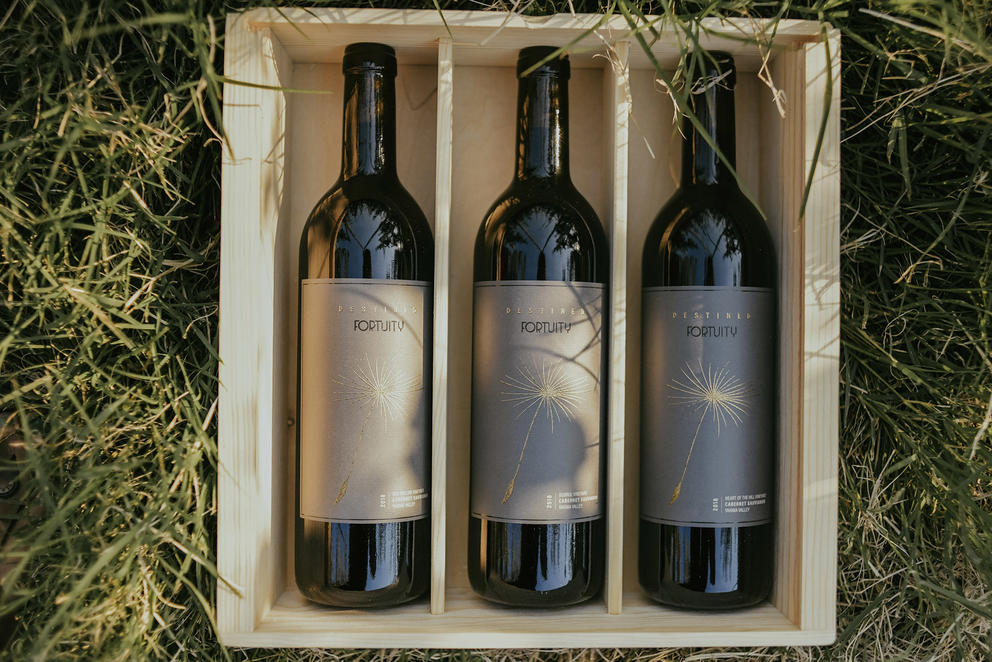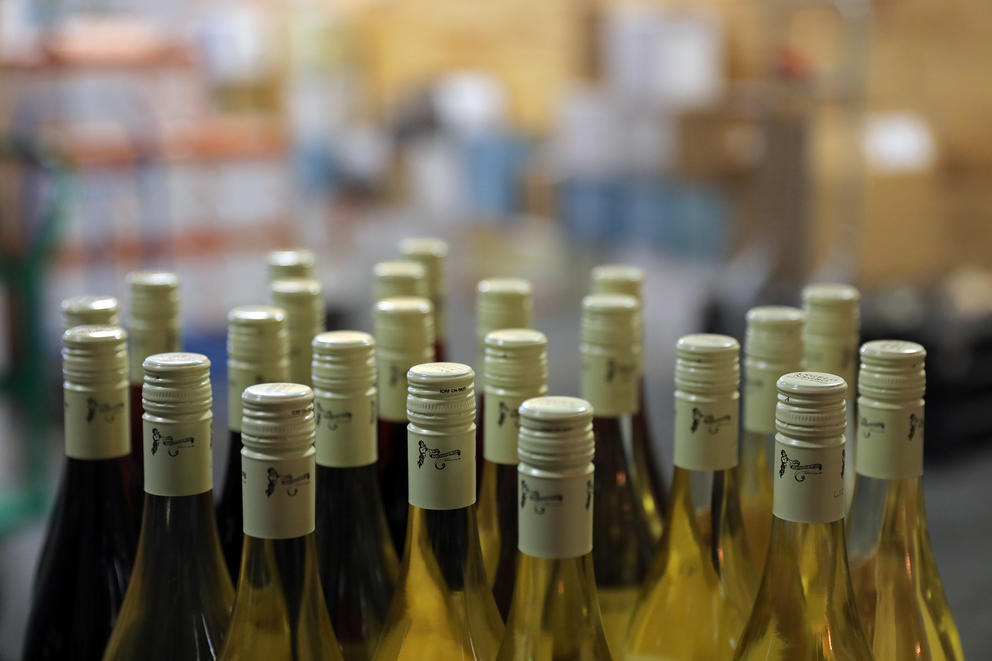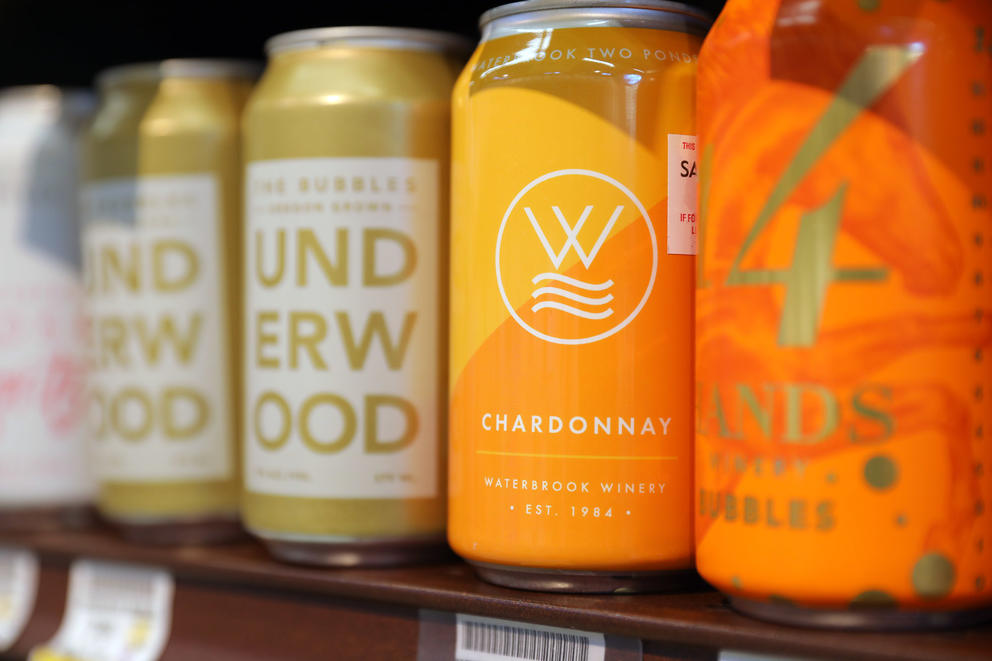Prosser’s Hogue Cellars, where Dinn was director of winemaking, met plenty of skepticism in 2011 when it did away with corks entirely and switched to screw caps.
And even when Dinn opened his own winery, Co Dinn Cellars, in Sunnyside a few years ago, he first talked to a fellow winery owner before deciding his high-end wines would be sealed with screw caps, which seal bottles better and are now thought by many winemakers to be superior to corks.
But tradition is at least as important as science in the wine industry.
“That’s why the cork just didn’t disappear — because it worked well enough; it’s predictable and easy,” Dinn said. “You can’t discount that.”
While the decades-old Washington wine industry is young compared with centuries-old European wine regions, traditionalism still reigns. And that’s reflected in wine packaging.
As recently as a few years ago, the industry pushed the belief that high-quality wines should come in a heavy glass bottle with a wooden cork closure and wrapped with aluminum or tin foil capsules on top.
But individual wineries are challenging those notions as they seek to reach a new generation of wine drinkers willing to forgo tradition and address environmental sustainability and supply chain issues.
The result: Wine drinkers can also enjoy good-tasting, high-quality wine that comes in a bag-in-a-box or in a can. And the traditional wine bottle is getting a revamp, too.
“It was a monoculture several decades ago,” said Gavin Sacks, professor and associate chair of food science at Cornell University. “Although glass is the dominant packaging category, it’s no longer the only packaging category.”
Is it necessary?
Five years ago when Lee and Emily Fergestrom started Fortuity Cellars, a winery in Wapato in the Lower Yakima Valley, the overall look and brand drove their packaging decisions.
They topped their bottles with a white tin capsule, matching the white labels they chose. The winery also used heavier bottles, an indicator of high-quality and high-end wines.
But in recent years, the winery has reevaluated those decisions in light of other priorities.
“We had more conversations about sustainability and what the industry can do,” Emily Fergestrom said. “We are in an agricultural-based business. Taking care of our people and land means something to us.”
The capsule was the first target because of supply issues. Labor strikes in France, where they were made, created challenges in getting materials promptly.
The Fergestroms also considered environmental impacts. A lot of energy was required to procure the raw tin, manufacture it into the capsules and ship them to Wapato.
While the capsules were recyclable in some places, the winery found that most of its customers didn’t realize that and just threw them away.
“We’re taking something from the ground, taking it to a manufacturing [plant], to just rip it out and throw it away,” she said.
The wine bottles for its high-end Destined by Fortuity collection have no capsule. The company worked with its designer on a label that would draw customers but also make using a capsule unnecessary.
Fortuity isn’t quite ready to get rid of the capsules on its main line — the clean white label and matching white capsule are a key part of its branding — but Emily Fergestrom said she will revisit that choice as well.
“If it’s the right thing for the environment, and you can reduce the cost and reduce the carbon footprint, why would you not?” she asked.
Meanwhile, Kiona Vineyards and Winery, in Benton City, in Central Washington, announced a year ago that it would put several of its wine varieties into lighter-weight bottles.
The move is the latest in a series of sustainability practices. For example, the company previously reduced the number of times its tractors go through the vineyard.
General manager JJ Williams said he hasn’t heard any negative feedback regarding the move to lighter-weight bottles, which was noteworthy, considering the wine industry’s push toward heavier bottles in the past.
“For 30 years, the collective we in the wine industry told consumers [that] when a bottle is heavy, it’s going to be good,” he said.
Kiona has documented its switch to lighter bottles on its website, outlining the benefits, including reduced shipping costs and positive environmental impacts.
“They like the transparency, they like the no b.s. aspect of being honest [with] margins and business decisions,” Williams said.
Communicating change
Explaining the need for change will come from the wine industry itself, namely because it shaped the culture and experience around the product, Williams said.
“Wine has a perception problem. There is an elitist, pinky-out stereotype of people who drink wine that in my experience is not accurate,” he said. “It’s the cultural zeitgeist belief about wine drinkers.”
And that could be an issue as the Washington wine industry — and the wine industry globally — competes with other alcoholic beverage categories, such as hard seltzers, beers and liquors, said Erin Palmer, owner of The Wine Cellar in Portland.
“We’re not catering to the 21- to 35-year-old crowd,” she said. “They’re turning into liquor drinkers and beer drinkers.”
At the same time, breaking wine culture norms will take time, she said.
Palmer knows this first hand. When she started selling wine two decades ago, the idea of wine bottles not having tin or aluminum capsules on the bottle was unheard of.
“The bottles that didn’t have a capsule looked out of place and people didn’t like it,” she said.
Palmer said she and the staff at her shop took it upon themselves to educate the public about the benefits of purchasing bottles without metal capsules, including reduced waste.
And the reasons to use the capsule in the first place — either to show the wine bottle’s authenticity from a certain winery or to deter rodents — doesn't apply today, she added.
Through those conversations, Palmer’s customers have become more comfortable with bottles that don't have capsules, some even making a point of purchasing wines without them.
Packaging can signal the values of a winery and show they are sustainability-minded or Earth-friendly, she said: “I say to my clients ad nauseam that every dollar we spend is a vote.”
And she encourages customers to tell wineries on social media when they make a purchasing decision with the environment in mind.
Often, wineries hear only from those unhappy with a change. “You got to have positive reinforcement,” she said.
Such feedback is valuable; there isn’t a lot of market research on wine packaging for Washington state wineries, said Jill Perillo Clark, wine studies program coordinator at Central Washington University.
While Washington state — with roughly 1,000 wineries — is the second-largest producer of wine in the U.S., it’s still far smaller than California, which has more than four times as many wineries.
Most wineries depend on social media feedback and anecdotical data from customers to influence their packaging decisions. Future decision-making would benefit from real data in a broad consumer study for the whole industry, Clark said.
Without that data, many wineries may not have the information they need to make a change away from the way they’ve always bottled their wine, in heavy glass with a wooden cork closure, said Dinn, the Sunnyside winery owner.
“The comments I get from other winemakers is, ‘I wish I could do that, but I can’t; I don’t know enough how it works. I don’t want to take the risk. What happens if it fails?’ ” he said.
Alternative packaging
Ste. Michelle Wine Estates, the state’s largest wine company, would be considered, until recently, a traditionalist, said Ryan Pennington, the company’s senior director of communications and corporate affairs.
The company, for example, had been slow to make the switch to screw caps, he said.
But in recent years, Ste. Michelle has started to consider different wine closures and whether its wines could be offered in something other than a bottle. In 2019, the company released cans for its 14 Hands brand, recognizable by its horse-themed labels.
“14 Hands typically has been the more modern, fun and light-hearted expression in the portfolio,” he said. “We thought the brand would be a good fit for trying [cans].”
Seattle-based Full Pull Wines, which offers customers a curated selection of wines through its email newsletter, has featured wine in cans and bag-in-a-box formats, along with those in traditional glass bottles.
Owner Paul Zitarelli said many of its customers have been drawn to the bag-in-box concept, namely because of its light construction, which makes it easy to transport to parties and other events.
“Whether it’s a can, box or light glass bottle, ultimately, it’s what’s inside that counts,” he said.
Sacks, the food science professor at Cornell University, has done research on wine quality when it’s stored in various containers and found that there are challenges — and advantages — that come with alternative packaging.
The seams of a bag-in-a-box wine, for example, often allow more oxygen to come in, which shortens the amount of time the wine can be consumed to just a few months. That's not ideal for wineries that need to store product for a long time or package wine just a handful of times a year, Sacks said.
However, the difference in wine oxidation when the package is closed and when it’s open is minimal, which allows for consumption for a longer period of time once a package is opened. An open bottle stays fresh for a few weeks at best, but a bag-in-a-box wine can be consumed for several months after opening.
Sacks is a proponent of cans as they can keep oxygen out and be stored for a long time.
Cans do have their own issues, however: Some sulfated wines, when they come in contact with cans, create a chemical compound that causes an unpleasant smell akin to rotten eggs. And sometimes, cans corrode and leak.
Sacks said he’s researching to see whether there is a way to prevent the quality issue — maybe by adding a plastic liner or limiting the use of cans to unaffected wine varieties.
In addition, canning is a specialized process and oxygen can get into the wine during canning if done improperly and ruin it.
Generally wineries that want to try canning often do it through a third party, not only because they don’t have a canning line, but also because they lack experience in the process itself, Sacks said.
The 14 Hands cans, for example, are bottled by Schilling Cider in Auburn, Pennington said.
A law passed during the 2022 Legislature will allow wineries to go to any alcoholic beverage provider, with a certain endorsement, to do canning. That includes breweries. Previously wineries were limited to working with other wineries, including cideries, which were considered part of the same beverage category.
Pennington said Schilling has been a solid partner in the canning process, but having more options is a good thing.
What's ahead
With new generations caring for sustainability as much as wine quality, demand for wine that reflects those values will increase, said Zitarelli, the owner of Full Pull Wines.
“There’s going to be less patience for those big heavy bottles,” he said.
Still, traditionalist wine culture isn’t going to go away entirely.
Even those who have been proponents of change said there’s still appeal in traditional glass bottles with a wooden cork closure. Some wine drinkers still prefer it.
Palmer, the Wine Cellar owner, said even knowing the environmental benefit and convenience of cans doesn’t mean you want to drink wine out of them.
“I want to open the bottle of champagne,” she said. “I want that experience.”






